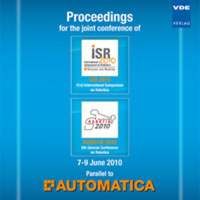euRobotics - Shaping the future of European robotics
Konferenz: ISR/ROBOTIK 2010 - ISR 2010 (41st International Symposium on Robotics) and ROBOTIK 2010 (6th German Conference on Robotics)
07.06.2010 - 09.06.2010 in Munich, Germany
Tagungsband: ISR/ROBOTIK 2010
Seiten: 8Sprache: EnglischTyp: PDF
Persönliche VDE-Mitglieder erhalten auf diesen Artikel 10% Rabatt
Autoren:
Bischoff, Rainer; Guhl, Tim (KUKA Roboter GmbH, Augsburg, Germany)
Wendel, Anne; Khatami, Fariba (EUnited aisbl, Brussels, Belgium)
Bruyninckx, Herman (Katholieke Universiteit Leuven, Leuven, Belgium)
Siciliano, Bruno (Università degli Studi di Napoli Federico II, Naples, Italy)
Pegman, Geoff (R. U. Robots Limited, Manchester, England)
Hägele, Martin (Fraunhofer-Gesellschaft zur Förderung der angewandten Forschung e.V., Stuttgart, Germany)
Prassler, Erwin (GPS Gesellschaft für Produktionssysteme GmbH, Stuttgart, Germany)
Ibarbia, Jon Agirre (Fatronik-Tecnalia, Donostia-San Sebastián, Spain)
Leroux, Christophe (CEA, LIST, Fontenay aux roses, France)
Tranchero, Bruno (Alenia Aeronautica S.p.A., Turin, Italy)
Knoll, Alois; Lafrenz, Reinhard (Technische Universität München, Munich, Germany)
Inhalt:
Over the last few years successful coordination activities have been undertaken within the academic and industrial robotics communities (EURON and EUROP), but both communities still struggle to overcome the community-internal problems regarding terminology and suboptimally coordinated transfer of research visions, technology, and people. The European Robotics Coordination Action euRobotics, which started on 1 January 2010 and runs for three years, aims at creating sustainable solutions to all of the above-mentioned problems. It will continue to implement a policy of targeted stimulation of relevant grass-roots initiatives that both communities have already experimented with in recent ears, but that have previously seen little success because of a lack of committed, professional and coordinated support. Two main objectives will be targeted: (1) the improvement of cooperation between industry and academia and (2) the enhancement of public perception of (European) robotics. It is hoped by the project partners that the planned activities, described in this paper in detail, will result in significant and prevailing advantages for robotics in Europe.


